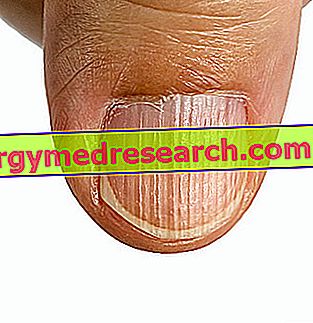Generality
Strips or streaks on the nails represent one of the most common problems affecting these skin appendages. This may depend on causes of various origins and nature.
In some cases, striped nails are small imperfections that indicate the presence of a trivial disorder; at other times, this anomaly is indicative of more or less significant pathologies.

To address the problem correctly, it is important to contact a dermatologist: the careful examination of the nail and an adequate medical history are essential for a precise diagnosis and to understand how to deal with the disorder with appropriate remedies and / or treatments.
What are
Nails are a clear indicator of physical well-being: if they have lines or streaks that cross their surface, they can be the light of a local disorder ( onicopatia ) or of a general malaise of the organism.
This anomaly manifests itself as a sign or symptom of multiple conditions, including: aging, trauma, immune-based diseases, metabolic disorders, infections and malnutrition.
Nails: key points
- The nails are skin appendages present on the tips of the fingers and toes. Their function is to protect the exposed phalanxes and limit their distortion following mechanical stress.
- The main constituent of nails is keratin, a filamentous protein, rich in sulfur, found in the hair and in the outer layer of the epidermis, the stratum corneum. The keratin tissue is divided into several layers and gives elasticity, flexibility and resistance to the nail plate.
- From the anatomical point of view, the nail is anchored to the underlying nail bed and insinuates itself into the periungual groove that surrounds it (perinichium), but separates from it at the level of the free edge (hyponymy). At the opposite end, there is the root of the nail, an epithelial area not visible on the surface, as it is covered by the nail fold. The stratum corneum which covers the first portion of the lamina, which emerges from the root, forms the so-called cuticle or epuncture.
- Cell growth occurs towards the free edge for 1-2 cm per month, varying from subject to subject.

Causes
The underlying causes of ruled nails are many.
Sometimes, the symptom is attributable to the onset of onychopathies (nail diseases). In other cases, on the other hand, it signals the presence of disorders and pathologies affecting different areas of the body, organs or tissues, whose effects, however, also occur at the level of these skin appendages.
The diseases and disorders that can affect the nails altering their appearance include:
- Infections;
- Trauma;
- Dermatological diseases (including psoriasis, alopecia areata and lichen planus);
- General disorders of the organism: nutritional deficiencies, various metabolic pathologies, anemia, allergies, thyroid disorders, vasculopathies, etc.
Even bad lifestyle habits can affect nail health. Prolonged contact with water and repeated use of solvents, soaps and detergents impoverish, in particular, the keratin of the nails, making them more dry and prone to breaking.
Smoking and the habit of biting nails (onicophagia) often worsen the situation.
Finally, ripped nails may depend on an excessively frequent and aggressive manicure.
Onicoressi
The appearance of streaks on the nail surface is the common expression of various local and systemic conditions. Usually, speaking of this problem, the term onicorressi is used, a phenomenon that can affect the nails of the hands as well as those of the feet.
The most common causes include:
- Nail fragility;
- Trauma;
- Lichen planus;
- Chronic eczemas;
- Rheumatoid arthritis;
- Vasculopathies (alter the vascularization of the matrix);
- Digestive problems;
- Deficiencies of vitamins (A, E, C and B6) and minerals (iron, zinc, selenium, copper, phosphorus and calcium);
- Anemia;
- Allergies;
- thyroid disease;
- Eating disorders (anorexia nervosa and bulimia);
- Particularly debilitating drug treatments.
Less often, this manifestation signals the presence of tumors that affect or compress the matrix.
Nails with thin vertical lines are also common in older people. The ripple is, in this case, a phenomenon linked to the natural aging process, related to the atrophy of the nail matrix. Another possible cause of ripped nails can be the prolonged use of semi-permanent enamels, a treatment that weakens them in the long run.
If the stripes are horizontal, instead, the cause could be the use of particular drugs, such as antibiotics or a lack of calcium and vitamins A and B.
Finally, if in addition to the lines, the nails also have a yellow color, it may be that you are facing a fungal infection or a case of nail psoriasis.
Onychomycosis
Among the various problems that can affect nails and cause streaks is onychomycosis. This infection is caused by some pathogenic fungi, which invade the nail plate forming small white asymmetric patches.

The triggering factors are many and include: trauma, reduction of the immune system and predisposing pathological conditions, such as diabetes.
Nail fragility
Fragility can occur with vertical streaks and cuts ( onicoresses ) or with progressive flaking of the more superficial layers ( onyx scia lamellina ). In the latter case, the lamina appears friable and undergoes a real fragmentation starting from the free edge of the nail, which takes on a jagged appearance.
Onychoresses and onicoskacy are common in the female sex and the elderly.
The origin of the striped and fragile nails can be:
- Repeated micro-traumatisms;
- Onychomycosis;
- Psoriasis, alopecia areata and lichen planus;
- Contact with chemicals at very acid or alkaline pH for professional reasons (eg chemists, health personnel, photographers and painters);
- Deficiency states, incorrect eating habits or drastic diets;
- General decay of the organism.
Aging is also a common cause of ragged and brittle nails, especially if environmental factors are added that promote nail dehydration.
Symptoms and complications
Ruled nails have parallel stripes, more or less pronounced, which run horizontally or vertically.
At the same time, the nail plate can be thinned and fragile, as well as having free marginal or fissuring measures.
Ruled nails can be a transient manifestation (due to the action of external or temporary factors) or persistent (when they represent the symptom of a more severe nail or systemic pathology).
The alterations of structure and shape make the nails without elasticity and prone to breakage.
Diagnosis
When presenting striped nails, it is essential not to underestimate the problem and contact a specialist doctor who will be able to provide the patient with all the necessary information.
The dermatological examination consists in the observation of the nail, also using sophisticated instruments such as videomicroscopy .
In the suspicion of an infection, a small portion of the nail is taken and then subjected to microbiological examination .
The dermatologist can also indicate more in-depth analyzes to investigate the causes of this anomaly and establish the treatment for the resolution of the underlying pathological conditions.
Therapy
The solutions to the problem of ripped nails are different depending on the factors or the triggers. The most appropriate treatment or remedy is therefore indicated by the doctor in a strictly individual way.
Supply
If the streaks depend on a problem of nutritional origin, it is necessary to intervene on the diet. The first step is to maintain a balanced and varied diet, rich above all in fresh seasonal fruits and vegetables, in order not to risk deficiencies of fundamental nutrients, such as proteins, minerals and vitamins (in particular, of group B).
In these cases, always on the advice and medical supervision, it may also be useful to use specific food supplements for nails and hair, according to the doses on the packages, indicatively for 2-3 month cycles. To know more:
- Diet and nails
- Nail supplements
Stress management
Physical and mental fatigue causes the loss of energy and compromises the correct functionality of certain organs, such as the intestine, causing, through the loss of vitamins and mineral salts, the formation of striated nails. If this symptom depends on stress, therefore, it is advisable to slow down the pace to recover a state of psycho-physical well-being, alternating one's daily activities with small moments of relaxation.
Pathological conditions
In the event that the cause of the ripped nails is a real pathology, such as a fungal infection or psoriasis, it becomes essential to resort to the doctor, who will prescribe the most appropriate therapy.
Onychomycosis requires treatments based on antifungal drugs and supportive treatments, useful for speeding up healing. For example, some nail lacquers create an environment hostile to fungus proliferation on the nail.
In the case of psoriasis, instead, it is necessary that the dermatologist indicate the most suitable therapy, even with the use of specific enamels.
Protective manicure and varnish
The valid rule for all types of striped nails is to perform the manicure and pedicure in the correct manner. These attentions are important to always have perfect hands and feet.
First, adjust the length and shape of the nails with a file (when you need to adjust a few millimeters) or a small scissors.
For cuticles, there are special wooden sticks or, alternatively, pens that release healing and restructuring formulas. After applying and massaging an emollient product for the cuticles, dip your fingers in warm / warm water for a few minutes. When the cuticles are softened they can be gently pushed towards the hairline with the special tool.
At the end of the manicure and pedicure, you can use a polishing file on the nails to smooth them and make them brighter.
Regularly, it is advisable to apply a hand cream rich in phospholipids and ceramides, or urea and vegetable oils (eg jojoba or sweet almonds). Alternatively, it is useful to massage a nourishing oil. Finally, it is possible to use a protective and strengthening enamel.
Some advice
The nails are skin appendages that need specific attention.
As for the hands, it is essential to use gloves to protect them from cleaning products during household chores. Likewise, direct contact with any substance that may be harmful to the nails (eg hair products such as dyes or perms, aggressive enamels or various detergents, etc.) should be avoided.



